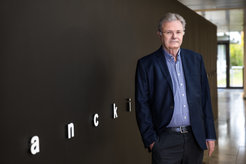ERC Synergy Grant for MPIB Director Wolfgang Baumeister
Communication processes between plant cells - Wolfgang Baumeister receives ERC Synergy Grant together with colleagues from Düsseldorf and Hohenheim
The professors Wolfgang Baumeister from the Max Planck Institute of Biochemistry (MPIB) in Martinsried, Wolf B. Frommer and Rüdiger Simon from the Heinrich Heine University Düsseldorf (HHU) and Professor Waltraud Schulze from the University of Hohenheim are jointly funded by the European Research Council (ERC). The "SymPore" project is now being implemented with over 10 million euros. The mission of this Synergy project is to elucidate the structure and function of the puzzling cell-cell connections of plants, the so-called plasmodesmata.

An organism consists of many differentiated cells, each of which has to perform different tasks. To do this, cells have to communicate with each other and exchange information. Only in this way they can coordinate their tasks for the benefit of the whole organism. In animals, this is partly done via protein complexes that form cell-connecting selective channels, so-called "gap junctions". In contrast, plasmodesmata in plants are much more complex: "Plasmodesmata are probably the most important and least studied organelles of a plant cell with immense significance for all aspects of the plant," says Wolf B. Frommer, head of the ERC project. "Plasmodesmata control both the exchange of nutrients and messenger nutrients, as well as the exchange of genetic information and even of proteins". Among other things, they prevent viral proteins or RNA from passing from one cell to the next.
But how this happens exactly is still unknown. "This is not least due to the fact that plasmodesmata are on the one hand too small, even for modern microscopy methods, and at the same time too large and complex for the usual structural elucidation," stresses Rüdiger Simon from the Institute of Developmental Genetics at the HHU. They have a diameter between 50 and 160 nanometers, with one nanometer corresponding to one millionth of a millimeter. They consist of probably hundreds of proteins and several lipid membranes. The researchers know that the structures under investigation are smaller than the resolution limit of optical microscopes. Even conventional electron microscopes can only inadequately image these highly complex structures of plasmodesmata. Plasmodesmata can be identified in the light microscope, but they can' t be examined in detail.
Wolfgang Baumeister and his colleagues at the MPIB in Martinsried are worldwide leaders in the elucidation of complex structures at highest resolution - down to single molecules - by cryoelectron tomography. The latest methods developed by Wolfgang Baumeister at the MPIB are now expected to achieve a breakthrough in this field and thus help to obtain an overall structural picture of the plasmodesmata.
With the help of cryoelectron tomography and by combining other state-of-the-art methods, it will be possible to understand the plasmodesmata. To this end, Wolfgang Baumeister has joined forces with three other research groups under the name SymPore ("Plasmodesmata as Symplasmic Pores for Plant Cell-to-Cell Communication"). Over the next six years, the scientists want to decipher the structure, the composition and the mechanism of the plasmodesmata.
The team agrees: "Only together we can succeed in developing an overall picture of the structure and function of plasmodesmata. This collaboration is now possible by the European Research Council with a Synergy-Grant!
ERC Synergy Grants
ERC Synergy Grants are a very highly awarded funding programme in Europe. They enable a team of leading researchers to bring together complementary skills, ideas, knowledge and infrastructures to jointly explore some of the most exciting and challenging questions in modern science. Synergy Grants are highly competitive, with only 34 out of 440 applications submitted being funded in 2020.
Further information: https://www.eubuero.de/erc-synergy.htm












